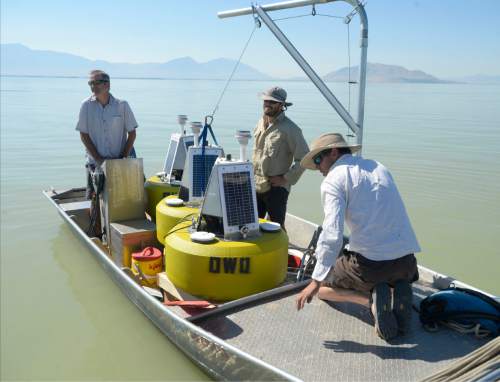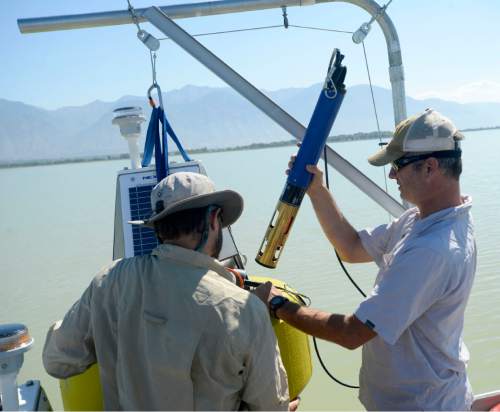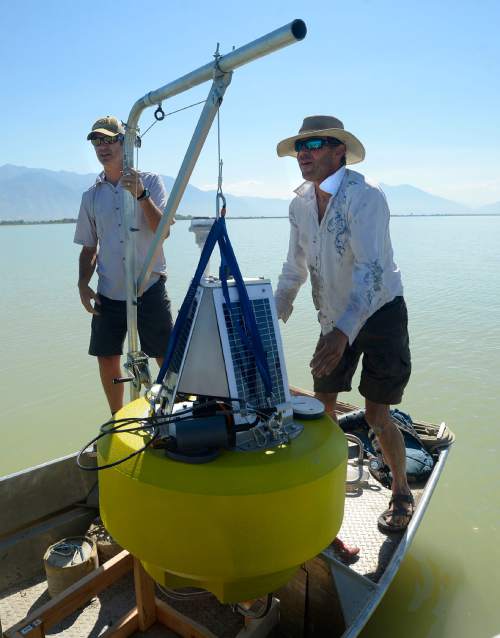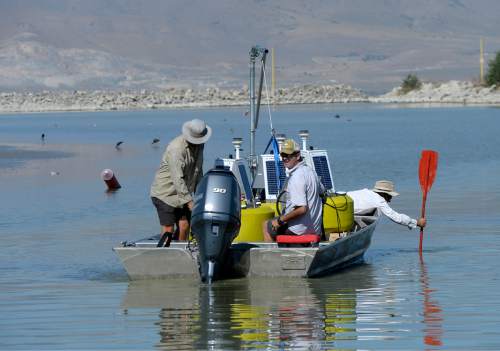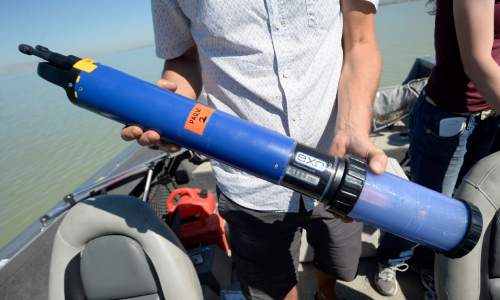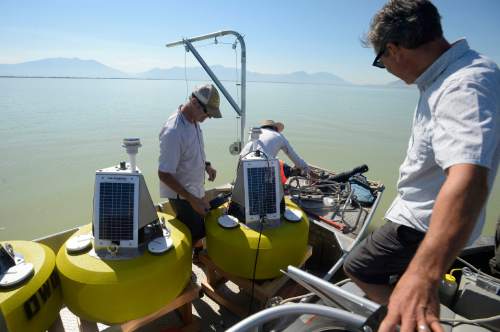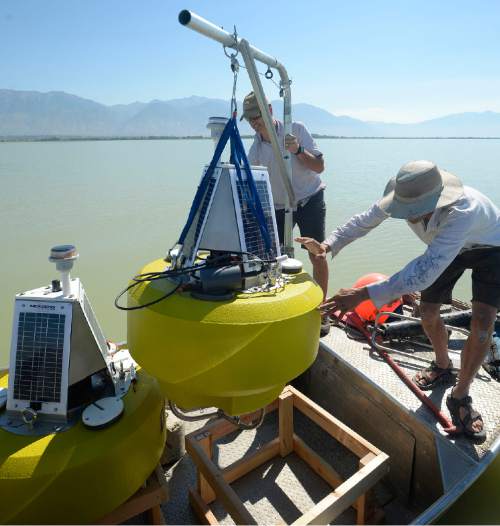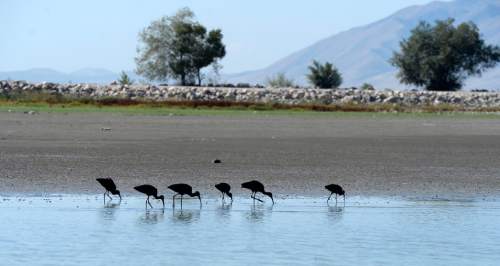This is an archived article that was published on sltrib.com in 2016, and information in the article may be outdated. It is provided only for personal research purposes and may not be reprinted.
Editor's note: This is the third in a series of stories exploring water-quality issues along the Wasatch Front.
Minutes into an excursion last week to dispatch new algae-tracking sensors into Utah Lake, one of the state's shallow-draft boats became mired at the outlet of the otherwise-desolate state park marina. As the Division of Water Quality (DWQ) crew worked to get the boat out into the water, they jokingly lamented their failure to bring an airboat.
Low water levels rendered boat access to Utah Lake almost impossible this year, said Eric Ellis, executive director of the Utah Lake Commission. Large signs at Utah Lake State Park declare the marina closed until next year; the boats that remain are docked in the adjacent parking lot.
That hasn't been good for recreation-oriented businesses on the lake, Ellis said, but the algae likely didn't mind.
"When water levels are low, it's easier for the lake to warm up" and foster algal blooms, Ellis said. "This year, the lake was low much earlier than it has been in past years, so we saw an earlier bloom because the lake warmed faster."
As this summer's massive algal bloom on Utah Lake so eloquently demonstrated when it forced the closure of downstream irrigation companies in Salt Lake County, water supply can suffer when the quality of the water renders it unusable. But the inverse is true as well — inadequate water supply can concentrate pollutants, making water quality more difficult to maintain.
While a number of factors converged to help drain Utah Lake this summer, experts have begun to fault some of the state's water management policies, which they say fail to take the bigger picture into account.
Managing Utah waterways with an eye single to human needs like irrigation and sewage treatment, said Walt Baker, director of the state Division of Water Quality, has "put us on a collision course for algal blooms to be the norm."
—
The DWQ has no authority to regulate water flow or allocation. That responsibility falls primarily to the Utah Division of Water Rights.
A water right, commonly referred to in Utah as "paper water," is a legal document that grants permission to withdraw a defined amount of water from a specific source. Water rights might be owned by a direct user, like a farmer, who uses the water to water crops. Or they might be held by municipalities or water companies, which then sell the water they withdraw to other users.
The Division of Water Rights stopped issuing new appropriations of water out of Utah Lake in the 1970s.
That means the only way to obtain permission to take water out of Utah Lake now is to buy an existing water right from someone else.
"We had reached a point where the users in the basin were approaching what was naturally available," said Boyd Clayton, the division's deputy director.
Still, the terms of some historic agreements have allowed the actual amount of water diverted away from Utah Lake to gradually increase, Clayton said, even though the number of water rights has not changed.
For example, someone with a Weber River water right who returns his or her unused portion of that water to the drainage basin encompassing Utah Lake is entitled to an equal amount of water from the Utah Lake basin.
This rule has been on the books since about the 1920s, Clayton said, but recently, more water-rights holders have claimed what are known as return-flow credits, increasing the amount of water diverted away from Utah Lake.
There are also a number of water rights in Utah Lake that have been dormant but have come back into use, further increasing demand, Clayton said.
—
Another system flaw, Baker said, is that in many cases, Utah hasn't taken the ecosystem's need for water into account.
Unlike many other states, Baker said, Utah has not established strong standards that require a minimum amount of water to be left in a lake or a river to preserve the aquatic ecosystem.
There is a mechanism on the books that allows the Division of Utah State Parks and Recreation to secure water rights for the purpose of maintaining minimum water levels, but that rarely happens, and no other entity may purchase unused water rights for conservation purposes.
Many water rights holders, the bulk of whom are farmers whose livelihood depends on the accessibility of water, fear water they may need one day will be taken from them in the name environmental interests. But Baker believes there may be a way to appease both groups.
In some states, he said, water-rights holders have the option to lease, rather than sell, their water rights to another party that essentially pays them to keep that water in the river. The person who holds the water right can use it if they need it, Baker said, but the water stays in the ecosystem most of the time.
There would be some long-term costs associated with the leases that would have to be paid by a governmental or nonprofit entity, Baker said, but this resolution might be more cost-effective in the long run than trying to clean up the leftover water that remains in Utah Lake.
This is why Leland Myers, who helped develop the state's rule requiring wastewater treatment plants to reduce their discharge of phosphorus by 2020, is opposed to additional such regulations. If you get wastewater clean enough, said Myers — manager of the Central Davis Sewer District — you open that water up for reuse.
And if that happens, he said, the state will be able to continue to grow its population for a longer period of time before it has to reconsider how water is distributed on the Wasatch Front.
"We need a holistic solution," he said, "and it needs to be economically viable, and some of that needs to be pushed into water rights, or we're going to suck the environment dry."
—
Laura Briefer, director of utilities for Salt Lake City, said that after this summer's events, she too has concluded that the state needs to approach water issues from a wider point of view.
While state officials and scientists were aware there was trouble brewing on Utah Lake, Salt Lake City was caught unaware when the bloom spread downstream and forced the city to find replacements for the water it pulls from Utah Lake.
"We'd had algal blooms on the lake before," Briefer said, "but we had never seen anything like this in the past, and hadn't anticipated that this kind of thing could occur, which to me painted a pretty strong picture in terms of the need for integrated resource management."
The current system, she said, has various state agencies looking at narrow issues — the Division of Water Rights deals with the legal aspects of who is entitled to what water, for example, while the Division of Water Quality is focused on what goes into the water.
Someone, she said, needs to take a step back and consider the overall situation.
"I do think people are doing their best to manage the frameworks they have," she said. "Now maybe we have an opportunity to manage things differently than we have, because now we've had a wakeup call."
And it's not just about the amount of phosphorus discharged into a lake, or the minimum amount of water required to be left flowing in a river, Briefer said.
It's also about looking at how climate change could alter the nature of the local water system, or at how the condition of streambanks and other riparian areas impacts the overall system's health.
The Wasatch Front, due to the interconnectedness of its waterways and the lessons taught by recent events, has the opportunity to sit down and talk about how all these factors determine the future of its waters, she said.
The challenge, she said, lies in whether Utah will be able to bring "a lot of diverse and valid opinions and perspectives to the table to ... work toward a common solution."
Twitter: @EmaPen


